75 years ago one of the most tragic periods in the history of Russia — the Great Patriotic War — finished. It took away lives of more than 20 million Soviet citizens. The long-expected day came on May 9, 1945. It was the Victory Day of Soviet Army and Soviet nation over the Nazi Germany.
On August 19, 1941 Veliky Novgorod was left by Soviet troops. Fascist troops spent a lot of days on the Novgorod land, plundering Russian heritage and destroying the city. German occupation lasted for 883 days. Only on January 20, 1944 Red Army soldiers planted their banner on the ancient Novgorod Kremlin walls. Courage, which Soviet soldiers displayed, including Novgorod people, knew no bounds. No wonder that in 2008, by Decree of the President of the RF, Veliky Novgorod was given a title of City of the Military Glory.
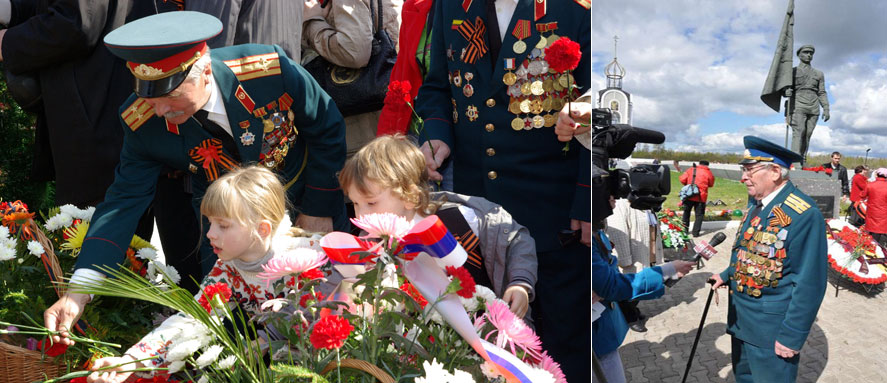
In the XXI century Novgorod people preserve and revere memory of the War, of the lost Novgorod citizens, of all who had to face the Fascist machine. In Veliky Novgorod many monuments, steles, memorial signs, obelisks remind us about this terrible event. We would like to introduce the route around the memorable military places in Veliky Novgorod.
At the entrance to the city, guests are welcomed by Prince Alexander Nevsky, who remained in the history as a valiant soldier, a wise ruler and a defender of the Motherland. No wonder that the title Name of Russia was given to Alexander Nevsky according to the results of the national poll in 2009. He won many battles and suffered no defeats.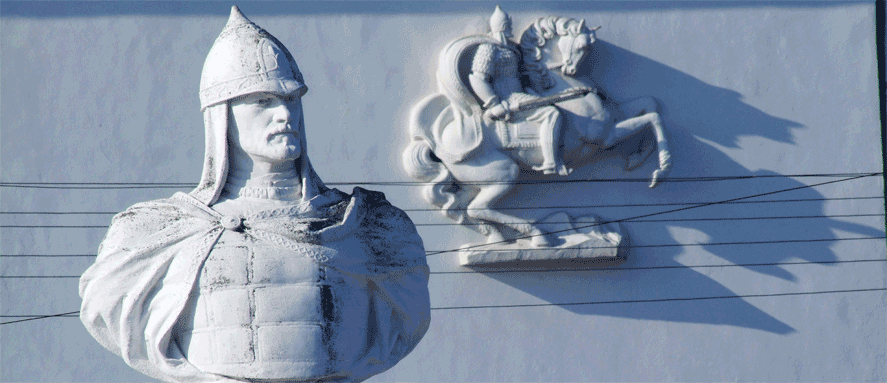
One can learn about the military history of Novgorod in the Hall of the Military Glory. Many times Novgorod territory was on the front line during defence of our country against invaders. The Hall of the Military Glory houses the exposition which reflects thousand glorious years of military history of Novgorod, for its people have always desperately defended their city and their motherland.
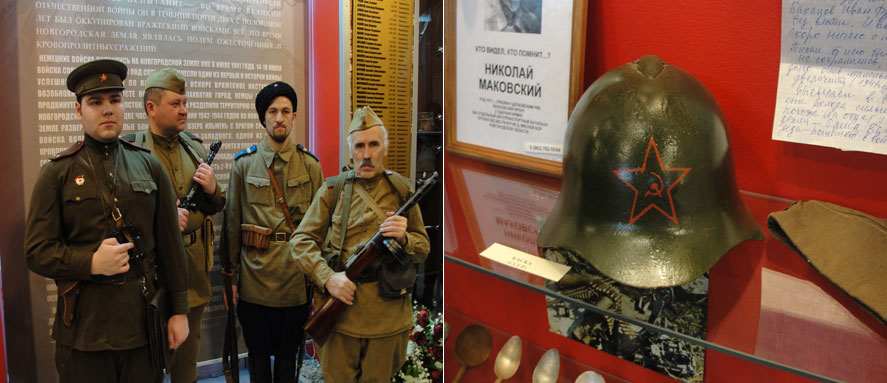
Not so far from the Hall of the Military Glory the stele — City of the Military Glory rises. It was opened on the eve of the 65th anniversary of the Victory Day. Granite ten-meter column, topped with the emblem of Russia, is placed in the centre of the square, close to the cinema Rossiya.
On the forepart of its pedestal, there is a cartouche with the text of the Decree of the President about giving the title the City of Military Glory to Veliky Novgorod. On the other side of the pedestal the emblem of the city is set. Four mini steles are placed at the corners of the square; one can see scenes of four historical periods of the military glory of Veliky Novgorod pictured on them: Ancient Rus, Moscow Kingdom, Russian Empire and Contemporary history.
As you move to the centre of the city you can't but notice the monument to Lyonya Golikov, established next to the Students Activity Centre. Lyonya Golikov, a teenager partisan, was born in Lukino village of Parfino district. In the years of the war he proved to be a true patriot of his country. Although he was so young (he went to the war at the age of 14) he took part in 27 military operations, annihilated 78 German soldiers and officers. He was honoured with the title of Hero of the Soviet Union posthumously.
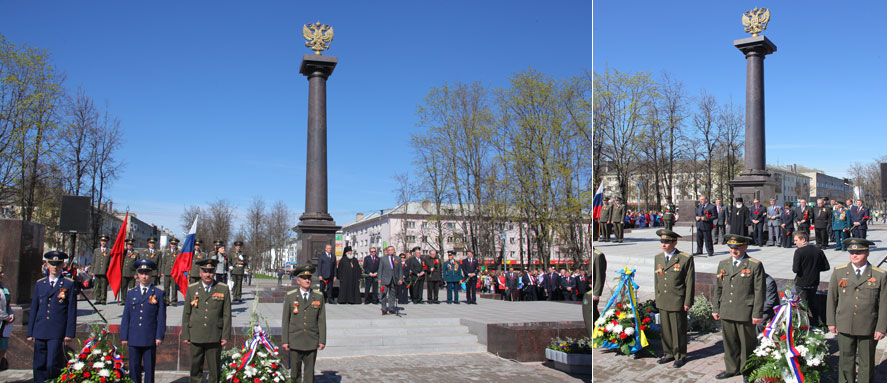
In the Kremlin, between Zlatoustovskaya tower and Voskresenskaya tower, which now doesn’t exist, the memorial Eternal Flame of Glory is located. It was set in the centre of the memorial 50 years ago on the 20th anniversary of the Victory over Hitlerite Germany.
A torch with flame was brought from Eternal Flame on the Field of Mars in St.Petersburg. “The basis of life lies in is the courage of the nation and it is immortal due to its heroic deeds. Soldiers of the Great Patriotic War lie here. They did everything for the Victory. Eternal glory to them.” Such words are carved on the memorial. And traditionally it is the place where events in memory of the war are arranged, veterans are honoured, flowers are laid in memory of the dead.
From April 30 to May 9, 2015 from 11:00 a.m. till 14:00 p.m. the Guard of Honour — renewed Post No.1 will be on the watch. Honorary Komsomol — Pioneer Post No.1 was established at the day of the 30th anniversary of the Victory. 40 years later 7-11 year students of military-patriotic club Fakel, students of the Municipal Centre of Patriotoc Education, students of Gymnasium No.2 and No.4 will pay tribute to the great national heroic deed, performed in the years of the Great Patriotic War.
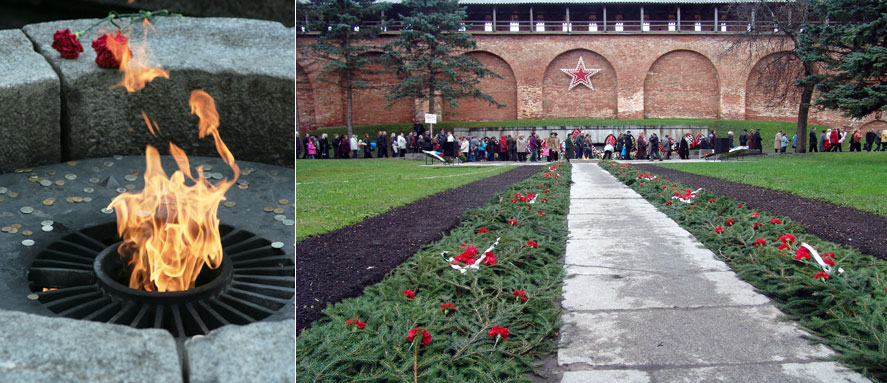
On the bank of the Volkhov, close to the walls of the Novgorod Kremlin, the monument of the Victory rises. The opening of the monument took place at the day of the 30th anniversary of liberation of Novgorod from fascist invaders. A horseman, sitting on the horse, which gets up, personifies a Soviet soldier with a sword in his right hand. Prostrated swastika is under hooves of the horse.
Total weight of the monument is 27 tons, height is 8 metres.
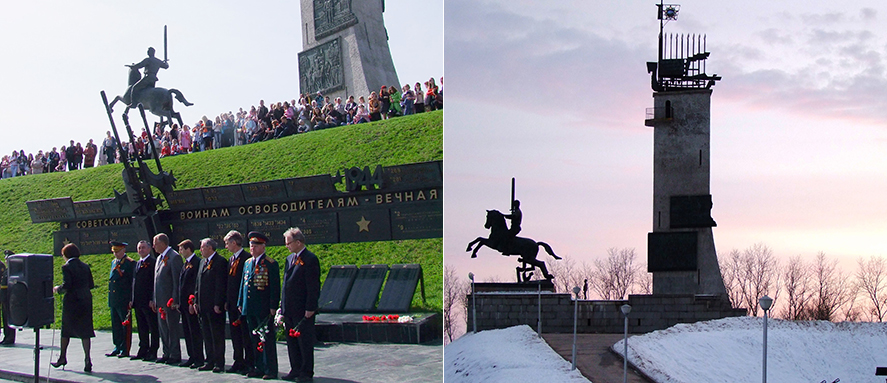
Here at the former bastion of a small roundabout city the Memorial Complex in honour of the 30th anniversary of liberation of Novgorod is situated. Two 76,2 mm divisional guns M1942 (ZiS-3) and the T-70m light tank protect the memorial. The divisional guns M1942 (ZiS-3) became the most popular gun in the years of the Great Patriotic War. The T-70m light tank lifted from the bed of Lake Ilmen and established on the Memorial Complex in 1964 took part in the liberation of Novgorod from Nazi invaders.
On the other bank of the Volkhov, on Yaroslav’s Courtyard between the church of St.Paraskeva the Friday and the river-bank, you will see the memorial in memory of Soviet soldiers. In January of 1942, Ivan Gerasimenko, Leonti Cheremnov, Alexander Krasilov blocked embrasures of German earth-and-timber emplacement with their bodies to save lives of their comrades. The soldiers secured success of their troop in the military operation due to this action.
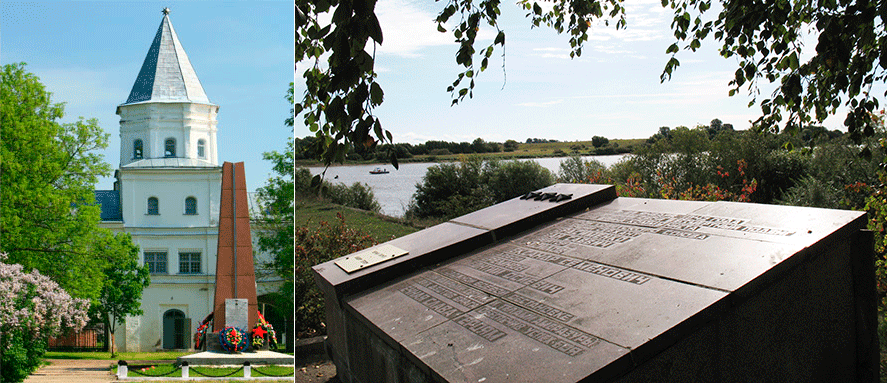
The first hero, who sacrificed himself in 1941, was Alexander Pankratov. During the battles for Novgorod Alexander closed the barrel of the enemy machine-gun with his body. The obelisk in memory to Alexander Pankratov the hero of the Soviet Union has been established on the exit from the city aside Moscow on the left bank of Maly Volkhovets river, where the battle took place. To see the hero term, established in the year of the 70th anniversary of the Great Victory, go to the block park where the Pankratova Street and the Rogatitsy Street intersect.
Not so far from that place the Defence Line memorial is located. “In August 1941, at that border the Hitler’s troops were stopped. 795 days and nights soldiers of the Volkhov war line blunted the attack of the enemy”. Such incription is cut on the monument. Next to the central stele, you will see the Tank T-34 that was the main battle tank of the Soviet Army.

Troops of the Volkhov front took part in the Novgorod-Luga operation in 1944. Novgorod was liberated. The monument to aicraft pilots of the Volkhov line — the plane MIG-17 was established in Kolmovo 40 years later after the Victory in the Great Patriotic War. The inscription on the plane says: “To aviators of the Volkhov front from grateful Novgorod people in honour of the 40th anniversary of the Victory of Soviet people in the Great Patriotic War of 1941-1945.”
One of the largest airfields of the North-West theatre of war was located in the settlement of Kresttsy of Novgorod region. The monument to the aviators of the North-West front — MIG-19 with red stars on wings and a tail rises on the entrance to the settlement. People always put flowers at the pedestal in memory of heroically fighting aicraft pilots of the North-West theatre of War.
In the direction of St. Petersburg, Death Valley is situated, next to the village of Myasnoy Bor. Dozens of thousands soldiers (Russian, German, Spanish) were killed here during the Great Patriotic War. Here Soviet soldiers died for Leningrad, which was under blockade. In January of 1942 Red Army tried to release the city on Neva, but the powers weren’t equal. This operation cost Soviet Army so many victims that the place was called the Death Valley.
Here in Myasnoy Bor Soviet soldiers took a stand for independence of their Motherland at the expense of their life. 20 thousand soldiers have already been laid to rest – at the military cemetry. The Memorial Complex is located on the 535 km of the route M-10 Rossiya. Next to the road the orthodox chapel is seen and also you can see the valley which leads to it. The chapel has neither walls nor doors and the dome is formed by metal contour elements. Granite slabs with the names of soldiers buried here are established on each side of the alley. The graves are situated beyond slabs.
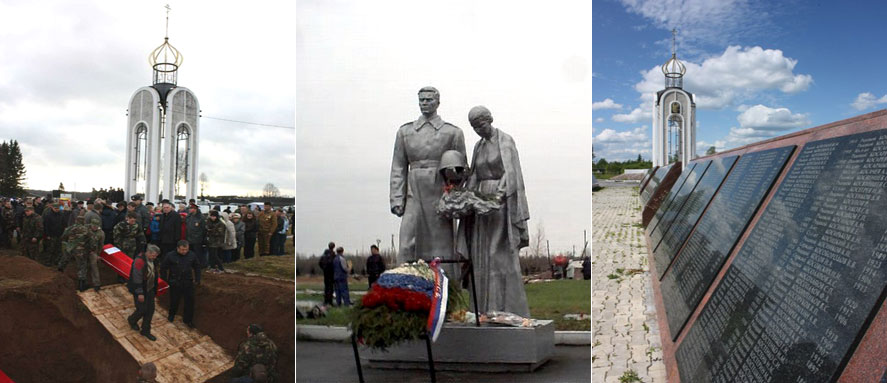
Search expedition Dolina in memoriam of N.I. Orlov searches the lost soldiers and bury their remains in the Novgorod territory. This organization is the largest search union in the country. Since 1988, remains of more than 115 thousand soldiers and commanders of Red Army were found, identified and buried by the people of the expedition, over 21 thousand names of defenders were recovered.
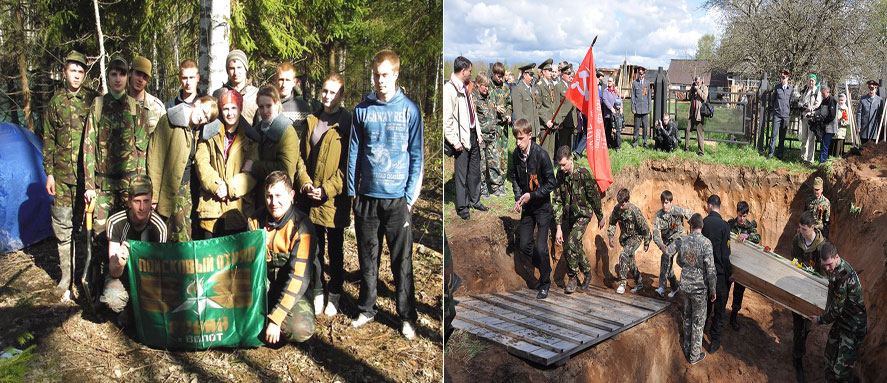
One more memorial complex is located in the Parfino district of the Novgorod region. Annually on the eve of May 9 at the military memorial Yasnaya Polyana inhabitants of the district and participants of the search expedition Dolina come together to honour the memory of those who gave us the Great Victory.

The common grave of Soviet soldiers is located in Western district of Veliky Novgorod on Korovnikova Street. It is no mere chance that the glave lies here. The street named after colonel general Ivan Terentyevich Korovnilov, who lead the 59th army. It destroyed the group of armies Sever and liberated Novgorod in the course of Novgorod-Luga operation.
Next to the Khoutyn Convent one can see the memorial of the 229th rifle division. Huge number 229 and the hand, keeping a rifle tightly, rise, as though growing from the earth, and are seen from far away. An inscription on the monument says: “Here 1075 soldiers of the 229th rifle division fought with Nazi occupants and fell in battles for the Motherland. March-April of 1943.” Every spring students come to the monument, put flowers here, commemorate the dead, and meet with veterans.
In Staraya Russa the unique museum – Museum of the North-West front is located. It is the first and the only museum in Russia, which tells us about one of the fronts of Red Army in the years of the war. Visitors of the museum have a unique possibility to see the events as if they were participants. Weapons of military years, models of Soviet and German technical equipment, interiors of partisan dugouts and underground safe houses are of particular interest. Many exhibits were handed to the museum by participants of military actions from Staray Russa.
